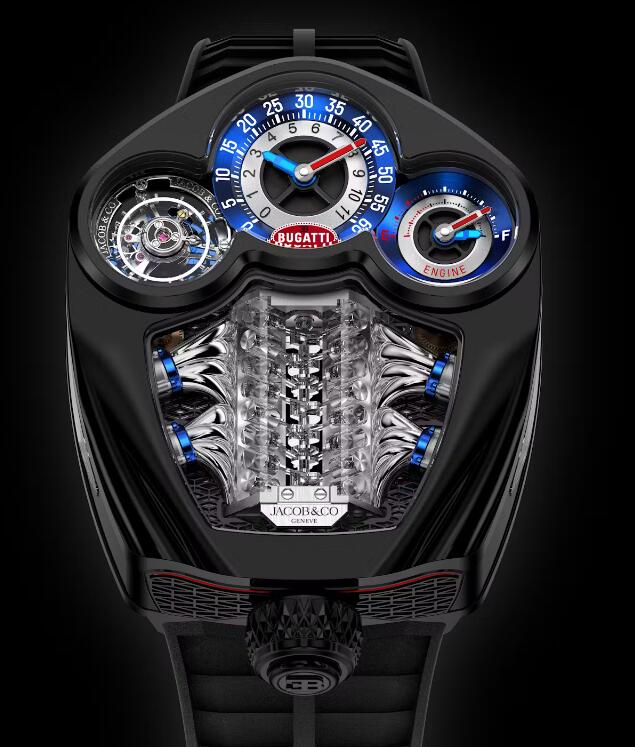
Jacob & Co. and Bugatti have once again revolutionized the world of luxury watches with the replica Bugatti Tourbillon.
More than just a watch, this piece is a mechanical marvel that embodies the synergy of two giants in their fields. For watch collectors, this piece represents the pinnacle of both horological and automotive craftsmanship.
Jacob & Co. has always been known for its innovative approach to watchmaking, pushing the boundaries of what is possible. Meanwhile, Bugatti, a name that represents the ultimate in automotive luxury and performance, has a tradition of building technologically advanced and beautifully crafted cars. The Bugatti Tourbillon is a natural extension of this philosophy, blending the art of watchmaking with Bugatti’s engineering prowess.
What sets the Bugatti Tourbillon apart from other luxury fake watches is its unparalleled design integration. Rather than simply taking inspiration from Bugatti’s latest supercar, this watch directly incorporates elements from the car’s design. The case measures 52 x 44 mm and reflects the car’s distinctive features, such as the front grille, side radiator inlets and large sapphire side windows. These elements are not only decorative, but are an essential part of the watch’s construction, making the Bugatti Tourbillon a true expression of integrated design.
One of the most striking features of this watch is its V16 engine block automatic, crafted from a single block of transparent sapphire. This element alone demonstrates the complexity and craftsmanship of this watch. The engine block houses 16 pistons made from high-grade titanium, all driven by a single crankshaft, one of the most delicate and sophisticated watch components ever created. When the automatic is activated, the crankshaft rotates and the pistons move up and down, mimicking the firing sequence of an internal combustion engine. This animated sequence can be performed 20 times in a single winding, showcasing Jacob & Co’s engineering prowess and artistry.
The Bugatti Tourbillon also features a 30-second flying tourbillon, the fastest tourbillon ever made by Jacob & Co. This tourbillon is not only a technical achievement, but also a visual feast, prominently displayed on the left side of the watch’s dashboard. On the right, a subdial indicates the power reserve of the movement and engine, while the center of the dashboard features an hour and minute subdial designed to resemble an RPM and speed counter.
Unique to the fake Bugatti Tourbillon is its retrograde chronograph function. Both the hour and minute hands are retrograde, meaning they jump back to zero after completing a 270-degree arc. This feature is a nod to the rev counters found in high-performance cars, which start at zero instead of the traditional 12. Each hand jumps to the next hour or minute and stays there until it moves again. For example, the blue hour hand jumps every 60 minutes, providing a dynamic and visually engaging way to tell time.
Jacob & Co.’s collaboration with Bugatti is more than just a simple co-branding. It’s a true collaboration that culminates in a watch that reflects the core values of both brands, namely excellence, innovation and attention to detail. This is fully reflected in the dashboard design, which closely resembles the interiors of Bugatti’s supercars. The dashboard of this watch and the dashboard of the car share similar aesthetics and functions, creating a seamless connection between the two.
The case of the Bugatti Tourbillon is designed to offer a panoramic view of the movement, just as Bugatti’s latest super sports cars display their technical details. A large sapphire opening on the side of the case provides a lateral view of the movement’s 557 components. The upper crystal offers a complete view of the engine block, its sapphire structure, the 16 pistons and the crankshaft below. The sapphire crystal under the case creates a clear transparency, making this watch as visually and mechanically stunning as it is.
The Bugatti Tourbillon is not only a watch, but also a limited edition collector’s item. Only 250 pieces of this watch will be produced, matching the production volume of Bugatti’s super sports cars. This exclusivity adds to the desirability of this watch, making it a coveted item for collectors. The first version is limited to 150 pieces in black DLC titanium, with other versions available in colored and precious materials and high jewelry.
For those who appreciate the finest things in life, the Bugatti Tourbillon represents the pinnacle of design and engineering. It is a watch that looks, wears and works like no other, embodying the spirit of Jacob & Co. and Bugatti. This watch is a celebration of two master craftsmen coming together to create something truly extraordinary.
Jacob & Co. fake has always been about more than just telling time, they are about creating experiences, stories and legends. The Bugatti Tourbillon is the perfect embodiment of this philosophy. For watch collectors, it is more than just a watch, it is a work of art, a technical marvel and a testament to the highest levels of craftsmanship and innovation. Explore the extraordinary world of Jacob & Co. and discover the unparalleled experience of the Bugatti Tourbillon.
